"Patent Pages"
by Ray Klingensmith
Reprinted from "INSULATORS - Crown Jewels of the Wire", August 1979, page 11
The October 15, 1872, Oakman Patent
The name Samuel Oakman probably
brings to mind a longer and more interesting insulator involvement than does any
other name to the insulator collector. Oakman was probably involved with the
production and invention of insulators longer than any other person in the
industry. He was associated with glass manufacturing, or the patenting of
insulators in the late 1860's, and perhaps earlier, thru the early 1900's. Many
inventions are credited to him, and his impact on the Boston area insulator
manufacturing was great. He had many patents, among them the October 15, 1872,
patents for a method of forming a screw thread on the inside of glass
insulators.
The "segmented thread" is a very familiar characteristic
of the Boston Bottle Works insulators to the collectors of today. These
insulators are found in a wide variety of styles and colors. The
"Bostons" have always gathered a large amount of interest, due to
their unique characteristics and scarcity. Most collectors rank them as one of
the more unusual and desirable items to add to their collection.
On October 15,
1872, Samuel Oakman, of Boston, Massachusetts, was granted two patents for
improvements in formers for segmentally screw-threaded insulators. The device
used may at first seem complicated (see complete patent copies), but after close
examination they can be easily understood. There were two separate patents, one
for four segment threads, and one for three segment threads. What the inventions
amounted to was a method of producing the threads in the glass in an easier and
quicker manner. I personally don't feel that Oakman had any ideas in mind for
any benefits from the segmented threads while the insulator was in use (as far
as insulation properties were concerned); it simply was an easier way of
manufacturing them, saving production time and, perhaps, production costs.
What
the invention consisted of in case A (#132,214) was a tubular plunger with four
equally spaced slots. Within each of these four slots was held a threaded
segment. This complete plunger was inserted into a mold containing molten glass.
After a short period of time, the interior bolt could be turned, which would
rotate the threaded segments one-quarter turn, that would place them inside the
tube, and expose a slotted portion next to the threads molded in the insulator.
In case B (#132,215) the product is somewhat similar in the result, but the
method of forming the threads is different. This one has a tubular plunger with
three slots. Within each of these slots is a threaded segment. The inner
portions of these segments (toward the very center of the plunger) are grooved
in a manner to grasp a shaft which runs vertically in the center of the plunger.
This shaft is tapered from a wide width at the top, to a narrower width at the
bottom. After the plunger remained in a mold containing molten glass for a
period of time, the inner shaft was drawn upward. The segments were attached to
this shaft, and due to the shaft becoming narrower as it was raised, the
segments would be drawn inward to a point, where, when the entire plunger was
raised, the segments would clear the threads formed in the insulator. Traces of
this method are evident in the three-segmented "Bostons". At the top
of the pinhole lines can be seen extending from the segmented threads toward the
center.
In the previous written material, I've
referred to the insulators made under the October 1872 patent process as
"Bostons". This is because some of the insulators made under that
process are embossed "Boston Bottle Works". However, all of the
insulators made with those threads may not have been made at Boston Bottle
Works, which I will explain as the story goes along.
The Boston Bottle Works was
listed in the Boston City Directory for the years 1872 thru 1877 as
"manufacturers of green, black, and amber glass ware; carboys, demijohns,
fruit jars, druggists' ware &c." (See copies of ads below.) Actual
production of wares may have taken place earlier than 1872. It seems to me that
perhaps the company was in business for some time prior to their listing in the
directory. Perhaps they were in operation as early as 1871 and were entered in
the directory for the next year.
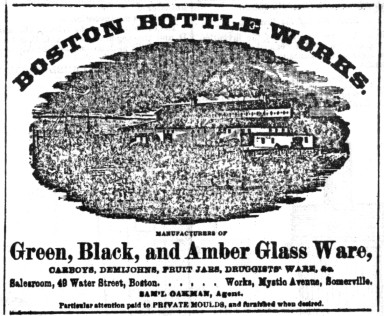
1872 Boston City Directory ad.
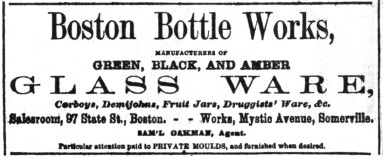
Ad from the Boston City Directory, 1873-1877.
More than likely, the first embossed
segment threaded insulators made at Boston Bottle Works were those marked with
"Patent Applied For", or "Patent Apld For". One can assume
the patent referred to in those embossings was for the segment threaded idea;
but it could have been for another feature. Insulators with both the Boston
Bottle Works and Patent Applied For embossing are found in four styles, these
being the following C.D. numbers: 145.6, 158, 158.2 and 158.9. Once again, it's
easy to assume that the above mentioned insulators were the first made under
Oakman's "segment" invention. However, there are some insulators (CD
136.4 and 158.2) with four segment threads which are unembossed. Were these,
perhaps, made by, or for, Oakman prior to his patent application? They could
have been made after 1877 and the existence of Boston Bottle Works. Maybe Oakman
made them while associated with another glass company at a later date. It seems
to me an earlier production date for these would be more likely. Still another
possibility would be a separate firm producing them without any ties to Oakman
at all -- a competitor in the industry.
Next we come to those insulators marked
with both Boston Bottle Works and the October 15, 1872, date. These, perhaps,
are the easiest to date. Most likely they were made between October 1872 and
1877. (The ones marked Patent Applied For could also have been made during this
same time period, as the plunger with that embossing could have been used for
several years, even though the patent was granted.) There are four styles found
with the B.B.W. and 1872 date embossings. They are found in the following C.D.
numbers: 127.6, 143.6, 158.2 and an insulator like the 158.2 without an inner
skirt (six sided dome).
There is also an insulator embossed "Chester 104
Centre St. N.Y. Patented" that has four segment threads. The embossing is
found at the base of the inner skirt on this item, as is the case with most
Boston Bottle Works items. Chester was a telegraph supply house in New York City
from the mid 1850's to the 1870's and perhaps later. These insulators could have
been made for Chester by Boston Bottle Works.
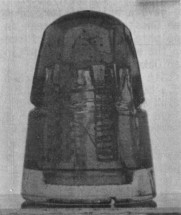 |
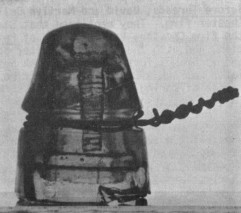 |
Tom Moulton photo
Insulator
embossed Chester 104 Centre St. N.Y.
Patented.
Fig. 1 |
Tom Moulton photo
Insulator similar to CD 136.7 with an inner skirt.
Fig. 2 |
They could have been made by
Oakman at a glass house after the existence of B.B.W.; or perhaps
Chester had them made by a manufacturer separate from both Oakman and B.B.W.,
which is doubtful. This particular insulator is presently listed as a C.D. 158,
although it is somewhat different than other C.D. 158's. The dome is shaped
somewhat different, and the wire groove does not circle the insulator in a
straight line as with other 158's. Instead, it travels in more of what
collectors call a wavy pattern (see photos in figs. 1 and 2).
Next we come to
those insulators marked with just the 1872 date and no reference to Boston
Bottle Works. I saved this embossing for last because I personally feel these
were made after the existence of Boston Bottle Works. Oakman was listed as
"agent" for the Bay State Glass Works for 1878 and 1879. The salesroom
for Bay State was at 97 State St., Boston (the same as for Boston Bottle Works
from 1873-1877). The plant was at 223 Bridge St., East Cambridge. I feel those
insulators marked "Pat Oct. 15, 1872" were made at Bay State in 1878
and 1879, or perhaps even later, by Oakman at even another glass factory. As
mentioned earlier, Oakman was very involved in either manufacturing or patenting
items as early as the late 1860's thru the 1900's. I would guess in any given
year in the 35-40 year span, you would find him associated in some way with the
manufacture of glass ware. After his association with Bay State in 1879, I'd
guess he continued the production of insulators with the segmented threads in
1880 and perhaps later, until he invented another improvement in forming threads
in insulators. This is referring to his September 9, 1884, patent, which was for
a collapsible plunger which formed a fully threaded insulator (that type of
threads found in the American Insulator Company insulators).
Evidence to my
feelings of Oakman making segment thread insulators after the existence of B.B.W.
is shown in the page from an 1880 Patrick & Carter Company catalogue on the
following page. The ad states that these could be made with what we term an
"inner skirt". That indicates they had someone (probably Oakman) still
making them. The ad suggests Patrick & Carter was not selling "old
stock" that had been produced a few years earlier, but were offering items
which could be produced as the customer specified. Note in the catalogue page
that Patrick & Carter are from Philadelphia. In their book, Before
Threads,
David and Marilyn Delling gave a brief history of the Chester firm. They
mentioned that Stephen Chester was a partner in the firm Chester, Patrick &
Co. of Philadelphia. With that information, and with the Patrick & Carter
page, the wheels started turning, and it brings forth perhaps a link between
Oakman and Chester and later Patrick & Carter. One can't be certain that
Patrick & Carter was an offspring of Chester, Patrick & Co.; but I am
assuming that Chester was associated with Chester, Patrick & Co. in the
early to mid 1870's. Then later, perhaps in the late 1870's, he withdrew his
interest in the company, and it became Patrick & Carter. At any rate, what
all the above means is that the C.D. 158 Chester could have been made by Oakman,
either at Boston Bottle Works (which I believe to be the case), or perhaps at
Bay State. Stephen Chester (brother of Charles in New York), while in
Philadelphia, offered the same line of material as the Chester firm in New York.
With Stephen's association in Philadelphia, the segmented insulators may have
later been offered there because of his earlier influence. (He could also have
been still associated with Patrick & Carter in 1880, even though he isn't
mentioned, but that's doubtful.)
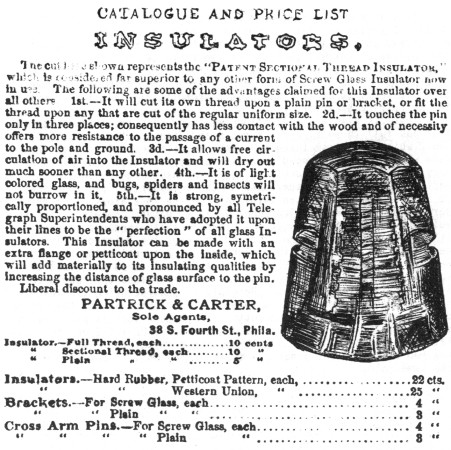
Page from 1880 Patrick & Carter
catalogue. The insulator offered most likely was the C.D. 136.7 with 1872 patent
date, with three segment threads.
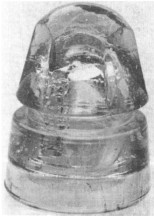 |
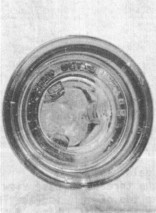 |
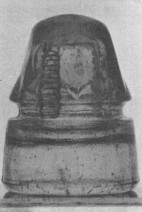 |
Bob Pierce photo
Insulator similar to CD 136.7
with inner skirt as described in above ad. Fig. 3 |
Bob Pierce photo
Base view of
fig. 3 showing inner skirt.
Fig. 4 |
Tom Moulton photo The CD 136.7
Fig. 5 |
It's interesting that in the printed material shown with the Patrick &
Carter insulator, mention is made that "it will cut it's own thread on a
plain pin or bracket, it offers more resistance to the passage of current
(because of the three segment threads), it allows free circulation of air into
the insulators". All three claims were probably not a factor in Oakman's
mind when he made the invention. It seems to me this was just a promotional
claim for advertising by Patrick & Carter.
There is also an interesting
insulator with the 1872 embossing that has full threads. (See figs. 6 and 7 for
photos of the C.D. 156.2 which has these threads.) This is very unusual in that
the date was for the segmented threading process. These insulators are very
scarce. I would guess these were perhaps made by Oakman in the early 1880's. The
threads found in these insulators are identical to those found in American
Insulator Company insulators. The threads were formed by Oakman's September 9,
1884, patent process. This involved a collapsible plunger which made a fully
threaded insulator. It's my belief that Oakman produced the C.D. 156.2
immediately after he thought of the collapsible plunger (prior to patenting that
idea). Perhaps he embossed the 1872 date on them so that in the event that
someone else saw the new method of forming threads, they would believe the idea
was patented. Possibly in manufacturing the insulators, the only mold he had to
form the inner skirt on was the one he used in making the segmented units. The
latter idea is probably the most likely to have happened. I don't own a C.D.
156.2 or the insulator similar to C.D. 136.7 with the inner skirt, so I can't
compare the two to see if the inner skirt was formed on both insulators by the
same mold.
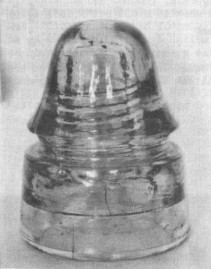 |
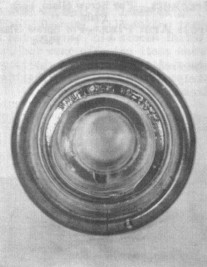 |
John McDougald photo
The CD 156.2. Notice the
threads stop before going to the top of the pin hole, similar to the Am.
Ins. Co. threads.
Fig. 6 |
John McDougald photo
Base view of the CD 156.2 showing the
1872 embossing on the base of the inner skirt.
Fig. 7 |
What we term as "Bostons", those
insulators mentioned above, including the ones not embossed Boston Bottle Works,
have been found in a very wide spread area. Some types seem to be from only one
area, while others were used in various places. Probably the most commonly found
"Boston" is the C.D. 158. This particular insulator comes with two
different widths of wire grooves. The wide groove measures 1/2 inch high, and
the narrow groove approximately 5/16 inch. Both seem to have been used in the
same locations, primarily along the railroads in New York State. Joe Maurath
reports that the report is the only one of any Bostons being used in
Massachusetts. In a recent phone conversation with Fred Griffin, I learned much
about the use of Bostons in the South, and I hope my notes are accurate on
what Fred mentioned. Fred stated that perhaps a couple dozen 158's were found in
a river that separates Florida and Georgia. These were both the narrow and wide
groove variants. The 158 has also been found in small numbers in various
locations in New England. After the C.D. 158, it would be hard to place the
Bostons in order of rarity, as there are many scarce ones.
Besides the
segmented threads found in these insulators, there are many other unusual
factors about them. The six-sided dome which is found on many of them is a
unique characteristic. The hex dome could have been for a better grip for the
lineman to turn the insulator on the pin, or, more likely, it could have been
designed to receive a wooden wrench, to help turn the insulator on the pin.
The wooden wrench theory becomes more acceptable when looking at the
"screw-top" Boston (see fig. 8 for a photo of the C.D. 158.9). The six
sided portion of the C.D. 158.9 is of a smaller area than the "signal
type" Bostons, and it looks more like a design made to fit a wrench. The
158.9 also has the interesting "screw-top". This unusual design
could have been made for some other reason, but I think Joe Maurath has come up
with the right idea. Joe states: "I estimate these were used with a cap
with a slot extending up into each side (see fig. 9A). Possibly, the wire was
held up inside the cap's slots while the insulator was screwed down onto the
pin, so that the stationary cap was screwed onto the insulator's top, with the
wire in place, needing no tie wire. This could have been achieved because the
crown's threading spirals opposite than the pin's."
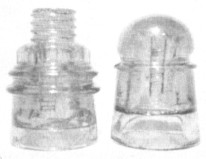 |
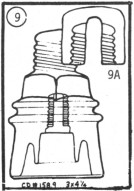 |
Cecil Boos photo
The screwtop Boston and the CD 143.6 with three segment threads.
Fig. 8 |
Joe Maurath
drawing showing the screwtop Boston and the cap ex plained in his theory.
Figs. 9 & 9A |
Joe continues: "To my knowledge, nobody has found
such a cap for the insulator's top. I'd imagine it would be very difficult to
find one, or at least a piece of one. If there was a cap, it was most likely a
cheap non-conductor of electricity like wood or glass. If it was glass, the
glass-to-glass contact would eventually break the cap; and if it was wood, the
same line conditions and the aging wood would eventually break the cap, dropping
the line."
Joe's theory seems very likely to be correct. The cap used on
these, if made of wood, would soon decay in the ground and would stand a very
slim chance of being in any condition to be found today. These insulators could
have been originally intended to be sold with caps, but after being produced and
maybe not being sold, perhaps they were later sold at a reduced price without
caps to be used as regular insulators. Does anyone own a C.D. 158.9 with wire
abrasions at the top of the screwtop?
The screwtop Boston has been found
primarily in the Augusta, Georgia, area, according to Fred Griffin. They also
have showed up in Alabama and Florida. Mr. Milholland, in a letter written to me
several years ago, made mention that divers had found them in the Indian River
in Florida. Fred Griffin mentioned an amber C.D. 158.9 that has been said to be
from Alabama, may have originally been located in Mississippi. Fred also
mentioned the dark green screwtop (if my notes are correct) was found in
Florida, and that some of the screwtops have threads on the top that appear like
they were "applied", something similar to the characteristic found in
American Insulator Company items. (This is referring to the creases found at the
bottom of the threads on the Americans, from the method of forming the threads
separately from the insulator and then "applying" them to it.) This
one also has an embossed triangle at the very top of the insulator. The C.D.
158.9 also comes in at least two height variations. Some have a screwtop with
four "threads", and some with six.
As far as color is concerned on the
Bostons, two things can be said: the colored ones are rare and beautiful! The
colored ones found so far seem to all have a color of their own, that is, there
is no other company that produced the exact color, and they are few and far
between. Probably the color found more often than the others (excluding the
aquas, of course) is the dark green. This is found primarily in the C.D. 158.2.
It is usually referred to as "emerald" green, but it has its own
unique color. The ambers are all very rare! Once again, I'd guess there are
probably more C.D. 158.2's in this color in collections today than of any other
C.D. number. I presently know of only one amber screwtop, one C.D. 145.6, and
two C.D. 158. The C.D. 145.6 is also known in a deep olive green. This is the
only C.D. number I know of in this color. The C.D. 136.7, which may have been a
later product, lacks any real deep colors. Most colored ones are of a lighter
shade, those being a light lime green, and a light lime green full of tiny
bubbles. There is one exception, however. One is known in a darker shade of
apple green. It is a darker shade, but is not the real deep color found in the
above mentioned items, which brings to mind the idea the reason for the lighter
color found in these perhaps could be due to the fact that they were advertised
(by Patrick & Carter) as follows: "It is light colored glass, and bugs,
spiders, and insects will not burrow into it. The unembossed C.D. 136.4, with
segment threads, which is most likely an Oakman product, is found in at least
four different shades of green. There also are some fully threaded C.D. 136.4 in
various colors with full threads, but, due to the fact that they did not have
segmented threads or were not embossed with the 1872 date, they have been
excluded from this article.
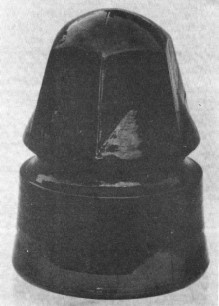 |
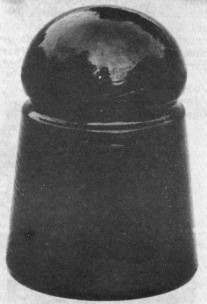 |
Bob Pierce photo
The amber
CD 158.
Fig. 10 |
Bob Pierce photo
The amber CD 145.6.
Fig. 11 |
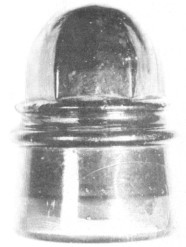 |
 |
Bob Pierce photo
The deep green CD
158.2 with dome embossing.
Fig. 12 |
John McDougald photo
The dark apple green CD
136.7 with 1872 patent date.
Fig. 13 |
It is interesting to note that all
the ambers, the olive green and some of the dark green, are found without the
patent date, but with "Patent Applied For". It indicates that most of
the colored glass was probably used in the earlier production. This is assuming
that those marked Patent Applied For were actually produced before the granting
of the patent on October 15, 1872. The ads which appeared in the Boston City
Directories throughout Boston Bottle Works existence clearly stated that green,
black and amber glassware was made; so in that respect it is rather surprising
that more insulators have not been found in those colors.
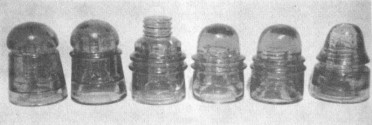
Cecil Boos photo
A
nice group of Bostons, including some of the rarer items.
Fig. 14

Cecil Boos
photo
The "Boston Signals", including the Chester, third from the
right.
Fig. 15

Cecil Boos photo
The "Boston Barrels". Green dome
embossed and green inner
skirt embossed, 2nd and 3rd from left. Amber, 5th from
left.
Fig. 16
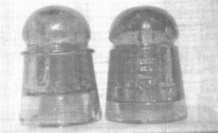 |
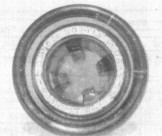 |
Cecil Boos photo
The CD 143.6 and 145.6.
Fig. 17 |
Cecil Boos
photo
Base view of the amber "barrel", showing the four segment
threads and embossing.
Fig. 18 |
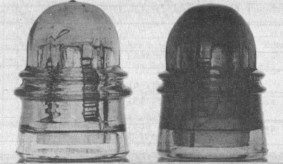
Tom Moulton photo
On left, the aqua
"barrel" embossed on inner skirt: Boston Bottle Works - PATENT OCT.15.
72-. On right, the green variant, embossed on inner skirt: Boston Bottle Works -
PATENT APLD FOR-. Note how the lower wire ridge projects further out than the
top one on the aqua, and on the green one both ridges are nearly the same.
Fig.
19
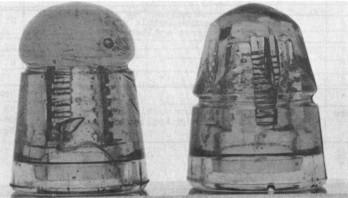
Tom Moulton photo
On left, a blue-aqua CD 145.6 which was found on the New
York Central Railroad, embossed: Boston Bottle Works - PATENT APPLIED FOR-. On
the right, the "narrow groove" CD 158 which was widely used in New
York State, mainly on railroads.
Fig. 20
Abbreviations used in the checklist are as follows:
| bl-aq |
blue aqua |
lt lm |
light
lime |
in skt |
inner skirt |
| lt yl |
light yellow |
bbl |
bubbly |
NE |
North East |
| dk ol |
dark
olive |
lt gr |
light green |
NW |
North West |
| dk em |
dark emerald |
gr-aq |
green aqua |
E |
East |
|
ap grn |
apple green |
|
|
in shldr |
Inner shoulder |
In the checklist are variants which I
have either seen or have had reported to me. Some of the material pertaining to
the location of where found, embossing, etc. is incomplete, so if anyone has any
additional info, please let me hear from you. Following are additional comments:
#5-7 One of these was found in the west -- not sure exactly which shade of green
it was.
#10 This item is most likely what Patrick & Carter advertised in
1880.
#11 I have seen this item and would call it a darker shade of apple green.
Unlike any other Boston color.
#12 The bubbly light lime green one is very
similar to the one listed as light lime green (#13), except that this one is
full of tiny bubbles. Both colors are very light.
#14 This insulator has the
same lettering as #10-13, with the exception that it's arced in the opposite
direction (at the bottom of the inner skirt when reading the lettering, rather
than at the top). Also it is a larger, script lettering.
#15 This insulator is
unusual in that it is three segmented and has an inner skirt. I believe this is
the same style as the C.D. 136.7 (same mold). The C.D. 158 has either a
5/16" or 1/2" wire groove. The 136.7 has a 3/8" wire groove, and
the dome is squattier looking, and that is the way this item is also. So rather
than having a regular C.D. 158, I believe this to be what normally would be a
136.7, only it has the inner skirt. This could be the insulator advertised by
Patrick & Carter as being available with an inner skirt.
#17 This insulator
is identical to the C.D. 143.6, except that it has an inner skirt. The one
specimen I viewed may have been intended to have an embossing at the base of the
inner skirt; however, due to what could have been an underpour, there was no
embossing.
#18 Could this be the same mold used for the C.D. 127.6, only with a
different plunger used with an inner skirt?
#20 This item was owned by a dealer
from Michigan many years ago. Due to the fact that #21 turned up in an antique
shop in Michigan also, I thought that perhaps both items may have been used on a
line in that state. I'll contact the former owner to see where the amber one was
originally located. (To my knowledge, both #20 and #21 are one of a kind.)
#22
This is the "American Boston", called such because of its American
Insulator Company style threads and the date found on many Boston Bottle Works
items. One of these was reported as having an embossing where the 15 was
embossed over a 12. Please advise if all are that way.
#23 Some of these may
exist without an embossing, due to an underpour. However, collectors have
reported they do exist unembossed with a fully poured inner skirt.
#24
Note that the C.D. 158 come in both a narrow and a wide wire groove. The exact
colors found in the 158's used on Cape Cod and also in the river between Georgia
and Florida were not known, so I did not include them in the listing of
"where found". But please note that they were found in those
locations.
#32-33 Made for the Chester firm which existed in New York City. One
of these was dug in St. Louis, Missouri. All others I've heard of came from the
U&D RR in Delaware County, New York. It has been reported by many collectors
that they were from the O&W RR (actually, the correct name is NYO&W) in
the same area. I believe these collectors to be in error, unless the U&D was
at one time a part of the O&W. I have talked with a collector in that area,
and they were used on the U&D. So, until someone can confirm their use on
the O&W, I'll omit it as a location where these were used. Also worthy of
mention is the fact that the dome is shaped differently than the regular C.D.
158, as there is a cutout or slot at the very top of the wire groove on three of
the six sides of the dome, and the wire groove is "wavy" rather than
straight. This insulator, interestingly enough, is formed in a three piece mold
(lines over dome), most likely made that way due to the shape of the wire
groove.
#38 Four of these were reported. Without seeing all four together, it is
difficult to say if they are all the same shade of amber. One was dug in the
Sidney, New York, area several years ago. It was believed to have been used on
an old cross country telegraph line, rather than along a railroad. Two others
came from an area some distance further southeast in New York State.
#41 This
embossing circles the top of the dome, and is usually rather weak. One was
reported with a backward "n" in the word "patented". All of
these may or may not be embossed with the error. Please advise.
#45 Some of
these have traces of embossing on the dome. The dome embossing referred to above
could have been attempted to be blocked out, and not all the letters removed?
#46 This item is shaped like C.D. 158.2, only it has no inner skirt. Also it has
three segment threads. The embossing reads: "PAT" or
"PATENT", not sure which. Found in San Francisco.
#47 This one is
embossed with "PAT". Almost certain it was found in the West.
#50
Embossed triangle on top of screwtop.
#51 Only one known at present. This is
about the same color found in the C.D. 158.2, except that, I believe, it is a
darker shade.
#52 Saving the best for last! This one probably would gather more
attention than any of the other 51 items described. Several collectors have
mentioned this one to me, and most refer to it as being from Alabama. One
collector stated it is believed to have originally been located in Mississippi,
and I would guess that to be correct, as the collector said the information came
from a knowledgeable source.
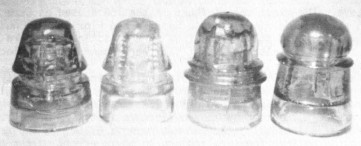
Cecil Boos photo
The three segmented family.
Fig. 21
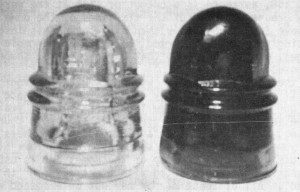
Cecil Boos photo
The aqua and amber barrels.
Fig. 22
Well, finally,
after days of writing, the article is at its end. There is probably more
information which I will realize I forgot once I send this to Dora, but I'm long
overdue in getting it to her now. This article was put together with a great
deal of help from many, many thoughtful friends. I'll try to list all those who
helped out in some way, and hope I don't forget anyone, there were so many.
For
sending very long detailed lists of many items in their large collections,
thanks to Cecil Boos, Tom Moulton and Bob Pierce; to Joe Maurath for the
"Boston ads", drawings, and quotes from his material; to Cecil Boos,
John McDougald, Tom Moulton and Bob Pierce for many fine photos; the Branhams
for patent copies; and for other help and information, Dave and Marilyn Delling,
Gerald and Esta Brown, Ron Gavin, Fred Griffin, John Hewitt, Kevin Lawless, Edna
McDonald, Bill Motisher, Larry Richards, Ed Wood and N. R. Woodward.
|
